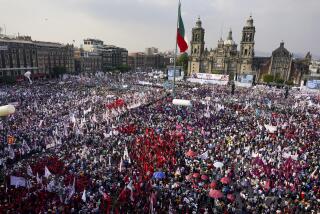Mexico’s Harsh Bribery Reality
- Share via
MEXICO CITY — Bribery is so entrenched in Mexico that more than 200 million shakedowns occur a year--or two for every citizen, a nationwide survey reports.
The survey of 13,790 heads of household, released Tuesday, reveals the extraordinary reach of bribery in return for public services, and the costs it extracts. The findings suggest that nearly 214 million acts of extortion or bribery occur each year in this nation of almost 100 million people. The annual cost to the nation of those illicit payments: $2.5 billion.
The average shakedown in Mexico cost 109.50 pesos, or $12, the study says.
Federico Reyes Heroles, an academic and writer who heads Transparency Mexico, which commissioned the poll, said the survey explodes many myths about corruption. For example, Reyes Heroles noted that it’s not the poorest states that have the worst records on bribery but two of the richest. The Mexico City federal district is the most corrupt, followed by the adjacent state of Mexico, according to the survey. Both are relatively well-off.
Reyes Heroles also said the study shows that corruption isn’t a function of any single political party. The widely held belief that the long-ruling Institutional Revolutionary Party, or PRI, has been responsible for most of the corruption in Mexico is belied by the survey results. The cleanest state turns out to be Colima, which is ruled by the PRI, while the federal district is run by the left-leaning Party of the Democratic Revolution, or PRD.
That the survey appeared at all, however, is an advance in Mexico’s anti-corruption campaign. In the past, Reyes Heroles said, the inclination of Mexican leaders was to deny that corruption was a problem and to contend that talking about corruption was somehow unpatriotic.
Now, Reyes Heroles’ nongovernmental organization is working closely with the administration of President Vicente Fox of the National Action Party, or PAN, in a combined and very public drive against corruption, including a campaign urging citizens to stop offering bribes to civil servants to get things done.
“The attitude of the Fox regime to the problem of corruption is much more modern” than that of the previous PRI governments, Reyes Heroles said.
The study also indicated for the first time which public services elicit the most bribes. It turns out that the four most common ones involve vehicles: Paying to keep a car from being towed or to get it out of the tow lot was the most common bribe. Second was parking in a prohibited area, followed by paying a traffic officer to avoid being ticketed or arrested. Fourth was paying to recover a stolen car.
Reyes Heroles said that ranking bribes should help authorities plan anti-corruption strategies and focus resources more effectively.
The most bribe-prone states are those with the highest rates of demographic change, including urbanization and seasonal migration. Following the federal district and Mexico state on the list of states with the worst corruption were Guerrero, Puebla and Jalisco.
Following Colima in the stakes for least corrupt state were Baja California Sur, Aguascalientes and Coahuila--all states with relatively stable populations.
Reyes Heroles said the survey also deflated the myth that only higher police and civil servant salaries will end bribery. He said the least corrupt states pay no higher salaries than the worst-affected states.
The survey brings an unaccustomed statistical spotlight to an issue that is highly sensitive among politicians.
“This will set off a ferocious competition between governors” to avoid having their states labeled as havens of corruption, Reyes Heroles said, “and that is very healthy.”
More to Read
Sign up for Essential California
The most important California stories and recommendations in your inbox every morning.
You may occasionally receive promotional content from the Los Angeles Times.













